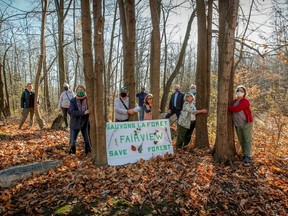On Saturday, the CSN took its members by bus to three green spaces in danger of extinction, to help them learn about the forests and the groups trying to save them.

Article content
One of the largest union organizations in Quebec is putting its social and political weight behind the struggles to save three threatened natural spaces on the island of Montreal; the grounds of Technoparc, Boisé Steinberg and Fairview Forest.
The Confédération des syndicats nationaux (CSN) is the second largest union federation in Quebec, with almost 2,000 member unions. On Saturday, the CSN environmental commission took a bus tour of those three green spaces, taking about 30 union members to the forest to see the threatened areas and speak with members of the environmental groups working to save them.
Advertisement 2
Article content
Article content
“At a time when some climate warming is sadly inevitable and when heat islands are becoming increasingly stifling, getting rid of forests and wetlands in Montreal is simply unacceptable and incoherent,” said Yvan Duceppe, CSN treasurer and spokesperson for environmental issues. . “We must preserve these three forested areas.”
The union demands that the City of Montreal, provincial and federal governments work together to protect these urban forests and wetlands. About 200 hectares of undeveloped land in and near Montreal’s Technoparc area, near Trudeau International Airport, are under constant threat of development. The nine-hectare Steinberg forest in Hochelaga-Maisonneuve is threatened by the extension of Assomption Boulevard. And Fairview Forest is a 43-acre mature forest and wetland area in Pointe-Claire that is threatened by a proposed development of condominiums, hotels and shopping centers.
Arianne Carmel-Pelosse, vice-president of the CSN’s Greater Montreal central council, said in an interview that it was during the United Nations COP15 biodiversity conference in Montreal in 2022 that many union leaders realized how important it is for the union movement. join forces with local environmental groups.
Article content
Advertisement 3
Article content
“We’re really making the link to heat islands and climate change that will affect everyone’s lives, including workers,” he said. “These three sites were chosen for our environmental trip, our bus tour, because we want our members to get to know these sites. We don’t often hear about many of these sites in the west (part of the island). There is a lot of talk about Boisé Steinberg, but not so much about the other two (Technoparc and Fairview).”
He said around 30 members from different unions responded to the call to ride the bus, including daycare workers, hospital employees and CEGEP teachers.
He said it is just as important for workers to become aware of the importance of environmental issues as it is for environmentalists to understand workers’ concerns as Quebec goes through the energy transition in response to climate change. While some politicians continue to suggest that society must choose between protecting jobs and responding to climate change, he said both can and should be priorities.
“We have to go quickly in this energy transition but without forgetting the workers in the non-renewable energy sectors, for example. We have to do both at the same time. The important thing is not to forget the workers. We can do a lot if we listen to the workers. “They are the ones who know best how to make changes in companies to make things as green as possible.”
Advertisement 4
Article content
Montreal is losing green space faster than the Canadian average for large urban centres. In its 2022 Environment Census The Statistics Canada program report noted that urban greenness is rapidly declining in Canadian cities. The report compared average greenness over the five-year period from 2018 to 2022 with a baseline period (2000 to 2004) and found that average urban greenness decreased eight percentage points across Canada. In Montreal, average greenness went from 78.6 per cent in 2000-2004 to 69.3 per cent in 2018-2022; a drop of 9.3 points.
“Areas with trees and vegetation improve local air quality, increase cooling effects, reduce wind speeds, absorb water runoff, provide habitat for wildlife, and offer recreational opportunities for people living in communities locals,” the report states.
Recommended by Editorial
-

Grassroots effort to preserve Fairview Forest is underway
-

Montreal mayoral hopefuls should say how they will protect the city’s precious few remaining wild areas.
-

Montreal to consult public on plan to build highway through Boisé Steinberg
Advertisement 5
Article content
Article content



